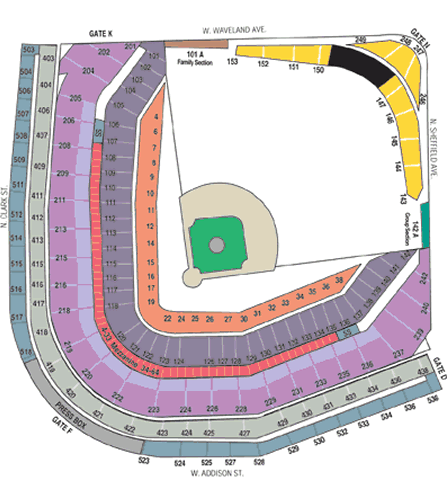The first park on Chicago’s North Side, Wrigley
Field cost $250,000 when it was built in 1914. Charlie
Weeghman built the park to house his baseball team, the
Chicago Federals (a.k.a. the Chi-Feds and, later, as the
Whales) of the brand-new Federal League, which was challenging
the established major leagues. The Federal League folded after
only two years, so Weeghman, leading a ten man syndicate which
included chewing gum magnate Willam Wrigley, Jr., purchased
the Cubs of the National League. The team was moved from West
Side Grounds to what was then known as Weeghman Park. In 1918,
Wrigley took over Weeghman's share of the team and by 1919 had
bought out the shares of the other members of the syndicate.
The name of the stadium was changed to Cubs Park in time for
opening day, 1920. It was renamed Wrigley Field in his honor
in 1926.
 The outfield bleachers went up in 1937 and the
scoreboard was constructed the same year by Bill Veeck. It is
still manually operated, and it still has never been struck
with a batted ball, although Roberto Clemente and Bill
Nicholson each hit home runs that barely missed. Sam Snead hit
it once with a golf ball teed off from home plate. Veeck was
also responsible for the ivy that gives Wrigley its
distinctive look. In 1937 he planted 350 Japanese bittersweet
plants and 200 Boston ivy plants. Eight Chinese elm trees were
also planted on the bleacher steps to complement the ivy, but
the wind from Lake Michigan kept blowing the leaves off and
after multiple attempts at replacing the trees, they were
removed.
The outfield bleachers went up in 1937 and the
scoreboard was constructed the same year by Bill Veeck. It is
still manually operated, and it still has never been struck
with a batted ball, although Roberto Clemente and Bill
Nicholson each hit home runs that barely missed. Sam Snead hit
it once with a golf ball teed off from home plate. Veeck was
also responsible for the ivy that gives Wrigley its
distinctive look. In 1937 he planted 350 Japanese bittersweet
plants and 200 Boston ivy plants. Eight Chinese elm trees were
also planted on the bleacher steps to complement the ivy, but
the wind from Lake Michigan kept blowing the leaves off and
after multiple attempts at replacing the trees, they were
removed.
The first permanent concession stand in baseball was
built here in 1914. The custom of allowing fans to keep foul
balls hit into the stands started here, as did the custom of
throwing back home runs hit by opposing players. "Take Me Out
To the Ballgame" has been sung (off-key) thousands of times by
venerable announcer Harry Caray (1914-1998), and countless
fans have watched the game from the porches and rooftops of
the houses on Waveland Avenue (behind the left-field fence)
and Sheffield Avenue (beyond right field).
After 5,687 consecutive day games played by the Cubs
at Wrigley, the lights were finally lit on August 8, 1988, for
a game with the Philadelphia Phillies. That game was rained
out after 3½ innings, and the first official night game took
place the following evening against the New York Mets. The
Cubs won, 6-4. Lights had actually been placed in the ballpark
for installation in 1941, but Wrigley instead donated them to
a shipyard for the war effort the day after Pearl Harbor. In
the late 1980s, however, Cubs management insisted that the
team was in danger of leaving Wrigley if lights weren’t
installed, and Major League Baseball threatened to make the
Cubs play postseason games at Busch Stadium in St. Louis.
Some classic moments in baseball history have taken
place at Wrigley, starting with the legendary 1917 pitching
duel between Jim 'Hippo' Vaughn and the Cincinnati Reds’ Fred
Toney. Both threw no-hitters for nine innings (the only such
dual feat in the majors) before the Reds’ storied Olympian Jim
Thorpe drove in the only run. Toney completed his no-hitter.
On Sept. 28, 1938, Cubs Hall of Fame catcher Gabby Hartnett
hit his famous "Homer in the Gloamin" off the Pittsburgh
Pirates’ Mace Brown. With the game about to be postponed
because of darkness, Hartnett hit a game-winning homer to lift
the Cubs to the pennant. Probably no event at Wrigley Field is
more famous than Babe Ruth’s supposed "called shot" home run
off Charlie Root in the 1932 World Series. It is now
acknowledged that Ruth did indeed gesture toward the outfield
just before depositing Root’s pitch into the bleachers, but it
may never be known just what he meant. The mystery only adds
to the mystique. It was at Wrigley that Ernie Banks hit his
500th homer in 1970 and Pete Rose got his 4,191st hit to equal
Ty Cobb’s mark in 1985. But the Cubs have never won a World
Series title at Wrigley Field, having lost in all six attempts
since 1918. Their last world championship came in 1908, six
years before Wrigley was built.

